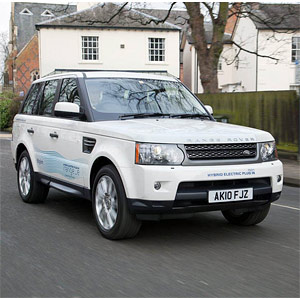Land Rover Plug-in Hybrid
As global consumers are becoming more concerned about environmental
issues, popular vehicle manufacturers are trying to present
fuel efficient vehicles that may emit less pollutants. Recently,
the Land Rover Plug-in Hybrid was introduced at the 2011 Geneva
Motor Show that created ripples in the 'green going market'.
This new "Range e" Land Rover PHEV is equipped with
a technically advanced diesel-electric power-train that is expected
to be available in the market with the future Land Rover models.
The first diesel-electric Land Rover hybrid is scheduled to
be launched in 2013.
It is certainly a positive move by the automobile industry
towards a greener and better future. The model of 'Range e'
is inspired by the Range Rover Sport model and it works with
the existing technology of 245PS 3.0-litre TDV6 engine. It uses
an eight-speed ZF automatic transmission along with a 69kW electric
motor. The new Land Rover Plug-in Hybrid model is a parallel
hybrid system and it can also work with a 14.2kW/h lithium-ion
battery and this battery system can be recharged by using a
240 Volts external power source.
The battery can be recharged by using a standard domestic power
supply and users can accomplish a complete recharge within four
hours. The same technology is also expected to be used with
'EV range' of Land Rover Plug-in Hybrid models and these models
will be able to support almost all short journeys in urban area.
Thus, these new Land Rover Plug-in Hybrid models are expected
to be highly suitable for those areas where it is necessary
to contain the fuel consumption and pollutant emissions. Nevertheless,
the major benefit of these innovative Land Rover models is the
fact that they will continually reduce CO2 emissions even during
the longer journeys by using the diesel hybrid 'drive-train'.
This is certainly an innovative step that will have a positive
impact on latest emission technologies.
The CO2 emissions of new 'Range-e' models of Land Rover Plug-in
Hybrid during long journeys is approximately 89g/km. However,
the maximum system output of these models is 339PS while the
maximum speed is around 193kph (120 mph). These models with
Land Rover Plug-in Hybrid system offer fuel consumption economy
of 85 miles per gallon.
The 'Range-e' Land Rovers are certainly amazing vehicles and
so are all other models of JLR. However, the success of these
models will depend on the prices at which the manufacturer of
these latest plug-in hybrid models will offer them. The well
known Automobile producers TATA group is offering these Land
Rover Plug-in Hybrid models and it will be interesting to see
how TATA introduces them in market.
|

